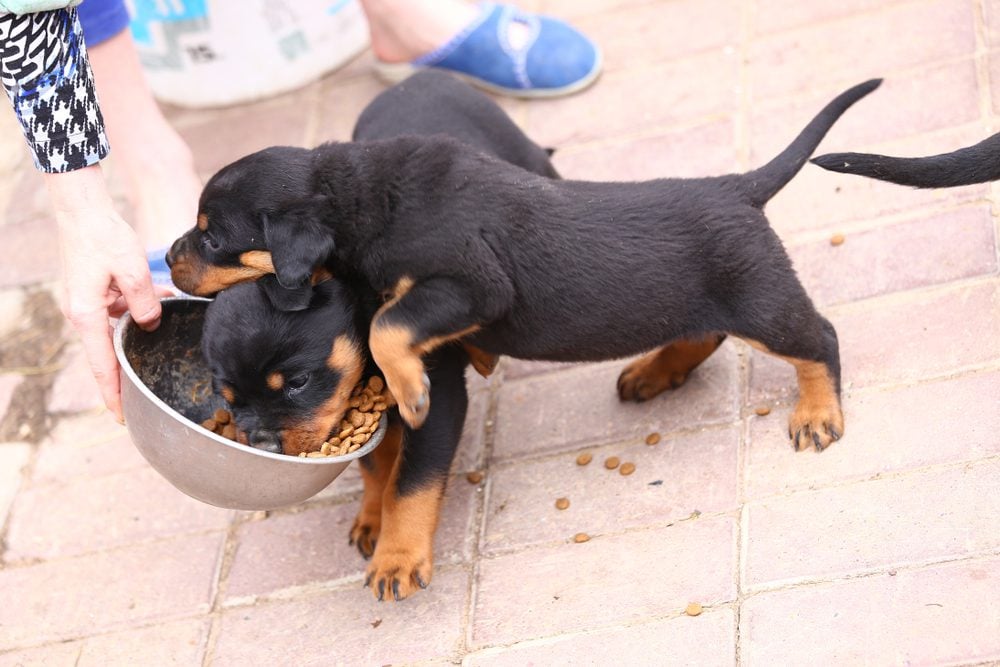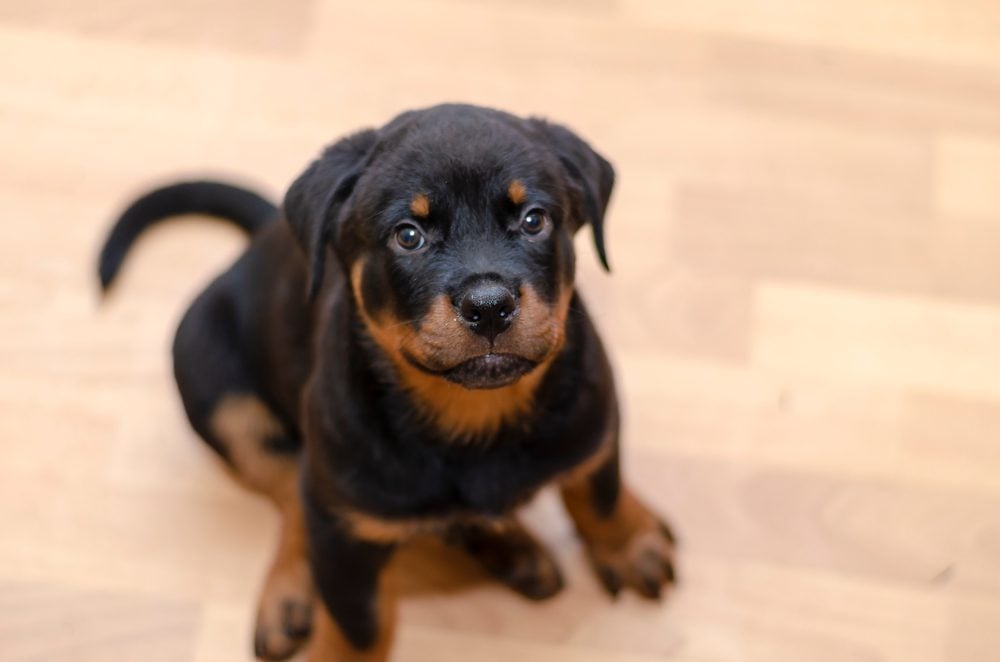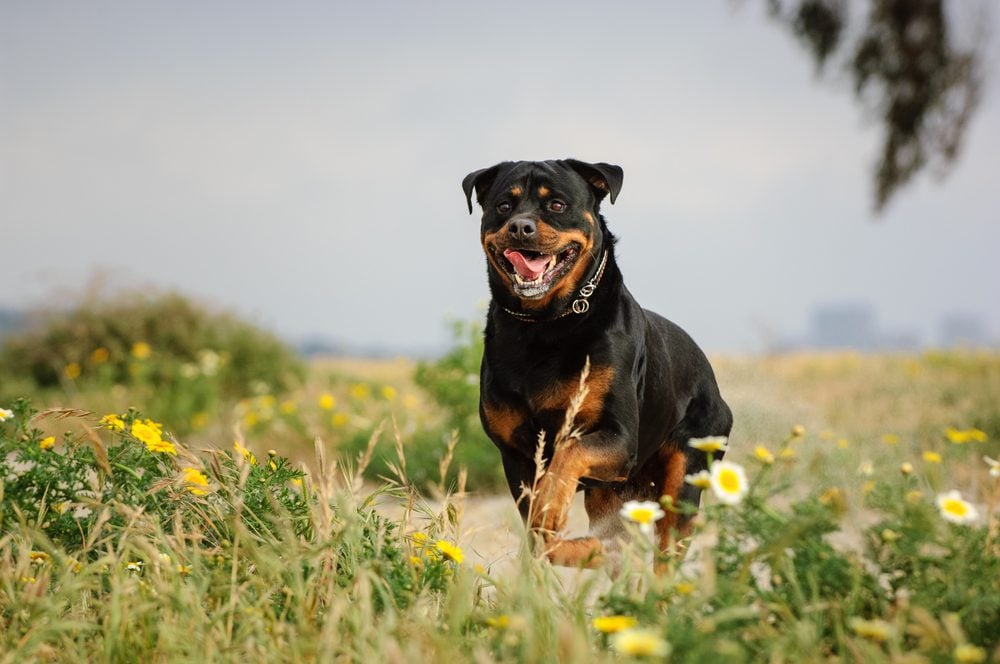It’s a complete myth that a Rottweiler can’t be trained as a regular household dog or that they are dangerous by nature. If they respect their owner and are well-trained, they are incredibly loyal, protective, and obedient dogs who are – as I’m sure you already know – absolutely gorgeous.
So we’re here in this article to show you how to train your Rottweiler, answer key questions, highlight key timelines to be aware of, and what variations in standard puppy training and Rottweiler idiosyncrasies you need to keep in mind. We’ll round off our article with some tips on specific training methods.
How Does a Rottweiler’s Nature Affect Their Training?
When you conjure up an image of a Rottweiler, you may reach for those classic filmic images of guard and attack dogs, the loyal servants of the protector, an all too familiar obstacle for the protagonist.
And it’s true that Rottweilers are absolutely excellent at this role. They have latent aggression, are prone to biting – even in play – and are very protective of their territory.
They are naturally suspicious of both new people and new dogs. You may think that their reactions are always out of aggression, but it’s not true. They also act the way they do out of fear. Keep this in mind and look for ways to comfort your dog in socialization training.
Therefore, imprinting leadership and being cautious and firm during socialization with other dogs and people is more important than it is with other dogs.
Is it Easy to Train a Rottweiler?
Despite their caricature, Rottweilers are actually easier to train than many other dogs. This is due to their ability to learn fast and the fact they are naturally very obedient and receptive to good training and leadership.
At What Age to Start Rottweiler Training?
You should probably start training Rottweilers as early as possible, somewhere around 8-10 weeks being ideal. This is when the fear imprint occurs, and it allows you to better curb and control some of the natural tendencies of the breed and to show them your leadership. At that age, you also have a better chance at socializing your Rottweiler effectively. This is when key obedience training will kick in.
7 weeks is the earliest, as that’s when the puppy is neurologically complete and can go to his forever home and begin training in earnest. Before this time, it’s the breeder who usually takes care of the training. If you wish to take this on, you’ll need to focus on more specialist puppy training.
Do note that at 8-10 weeks, their attention span won’t be as good as an older puppy’s so you will have to take your time with them. With Rottweilers, it’s definitely good to start young, though.
For socialization training, 11-16 weeks is the most important time and where they will learn the best, so aim to introduce them to other puppies and people around this time.
What Type of Training is Best for Rottweilers?
The most successful style of training for Rottweilers is operant conditioning. This is a four-quadrant process, including positive reinforcement, negative reinforcement, positive punishment, and negative punishment. All four are useful, but positive reinforcement is the most important at the start and should be the only one used at the very beginning of your training.



Positive reinforcement is the quadrant of training that rewards your dog for actions you would like them to repeat. A good way to do this is to set up training so that it is like a game.
Using treats, toys, or just simple praise. Whenever the dog follows the action you desire, reward them! Withhold said reward when they fail (but do not introduce negative reinforcement – yet!).
Remember with treats, a dog has roughly two seconds between stimulus and reward for them to effectively associate the two. So be sure to dole out the treat as soon as the dog completes the desired action. Getting your dog to come to your side, but then only rewarding him once he also sits will only associate the reward with “sit” not “come.”
Rottweilers do not need to be completely mollycoddled though. They respond particularly well to authority so don’t be afraid to be commanding and/or disciplining with them once they are out of very early puppyhood.
Note that discipline or punishment does not mean yelling or striking your Rottweiler. This will only create fear and resistance in your dog and further exacerbate their difficulty at following the commands you are giving.
How Do I Make My Rottweiler Obedient?
Here is an article on basic obedience training. Your breeder will likely have imbued and inculcated the dog with some of this anyway. But when it’s time for you to take the reins, remember the three Cs!
Be consistent,
Be confident,
And use cues!
Consistency is the key. If you pet and smother and treat your dog the first time they jump on the couch, and bark at him (pun intended) the next time – they’ll get confused about what to do.
Also, as we’ve said, Rottweilers respond better than most dogs to leadership, so being confident is essential. You are the alpha of the pack, and your dog needs to understand it. If you are shy, timid, or feel out of control, your dog will sniff it out on you, and will not respect your commands.
Just remember, confidence doesn’t mean shouting or striking. Rather, use appropriate cues. Talk loudly, yes. Keep your voice deep and low. Use simple words like “Yes” / “NO!” / “Good dog” / “Bad dog.” Your dog will start to learn these as positive and negative sounds and react accordingly.
It’s asking rather too much of even the smartest dog to say “I’m really happy with you right now” or “I’m so disappointed in your behavior.” Also, they’re a mouthful, and difficult to repeat consistently. So keep it simple!
Be physical by using a leash or your hands if necessary to orientate them to what they need to do. But always be kind and firm rather than cruel or forceful.
How Do I Stop My Rottweiler Puppy From Growling and Biting?
It’s normal for dogs to nibble and eat away during playtime. Rottweilers, however, can be particularly “nippy” and also have a tendency to growl, especially when they’re frightened or with new dogs or people.
This is why good leash discipline is important. If the puppy is acting this way, be sure to put them on a leash and time them out for at least a minute. Rottweilers respond well to authority that is firm yet kind.
Be sure that the puppy is not acting this way for other reasons, such as being hungry, dirty or feeling afraid. And if so take steps to remedy it before immediately leaping to punishment training. This will only cause more problems down the road.
How Do I Stop My Rottweiler From Eating Everything?
Rottweilers love to eat. They are notorious for being overweight. A podgy Rottweiler is a far more common sight than many other dogs. It doesn’t necessarily mean the owner has been careless either. You may follow a perfectly normal diet of treats and food for a dog, and then find your Rottweiler with a giant belly. It speaks partly to their metabolism, but also to the fact they’re probably sneaking illicit food somewhere.



The best way to cope with this is simply to use low-calorie treats when trying to reward them and use positive reinforcement. This way you can still treat them as much as they deserve, but they won’t bloat as a result. As Rottweiler training also tends to be longer than standard dog training, you may find using more treats. It’s here, once again, a low calorie treat can do well for you.
How Do I Socialise My Rottweiler?
You socialize your Rottweiler the same way you socialize any other dog. The difference is with Rottweilers you’ll have to be a lot more patient, a lot more careful. A well socialized Rottweiler will never be a threat and will be as good in social situations as any other dog. It will just require a longer and more involved process to get them there.
The key tenets of socializing your Rottweiler are as follows. Take your puppy out for walks, keeping them on a firm leash and don’t be hesitant to pull them away quickly from other situations when they are first out in the big wide world.
Rottweiler aggression is based on fear and suspicion more than anything else, so positive connections with other people and puppies will encourage your Rottweiler to follow suit. If a situation seems to be going negatively, just yank them away and move on. It’s essential to have positive and happy situations for your young Rottweiler until they can learn to curb their natural fear and suspicion.
Organizing playdates with children in happy scenarios or general moments of love and laughter will teach your young puppy how to interact well with humans. It’s also great if you can get confident dogs around your Rottweiler so that your dog can sniff the other dog’s rear and become comfortable. So see if any of your neighbors or friends have a confident dog that can assure your Rottweiler not to be overly suspicious all the time.
The First Two Weeks – Bringing your Rottweiler Home
Once you bring your dog home and train them within the 8-10 week period, here are the key things to keep in mind.
Learning Basic Manners
Try to be reasonable with the first expectations for your Rottweiler puppy. Some basic goals like lying down, not begging when food times begin, coming to heel when visitors come over and coming when called – without getting distracted – are good beginning goals. They may not necessarily meet them right away. Yet keep reemphasizing good behaviors. We have some good tips for this later on.
Introduce Grooming, Including Nail Care
Rottweilers get nervous, but they don’t get as stressed as other dog breeds. It’s a key difference, as it means they take to grooming and nail care well. If you do it straight away. Leave it too long, and their size and strength of will can mean they start to resist you.
When a dog arrives in your house, immediately start a grooming routine. For the first two months, twice a week is expected until they realize the habit. A treat is also suitable for these moments.
For bathing, you don’t need to bathe your dog with extreme regularity. Once a month is perfectly fine.
Potty Training Your Rottweiler
Rottweiler potty training is the same as any other dog. The breeder should have taken care of most of the early training. Just make sure you reinforce early on during that first crucial week about going outside when they need to as they’re getting used to their new space, and treating them when they do! However, as time goes on, don’t treat your dog every time they go potty outside. That is ultimately unhealthy.
If the worst happens, and the dog spoils your new shagpile, don’t yell, shout, or rub their noses in it. It will only create fear and make them more likely to do it again. Express disapproval. Send them to their cage or time them out. And positively reinforce going outside again for a while.
Training Tips – Basic Commands
Now it gets to the good part. Rottweilers are very receptive to learning commands. Among all the breeds, they rank very highly at responding to cues and instruction. This speaks to their natural intelligence, but also their loyalty.



That’s not to say they don’t get bored easily. Don’t expect to be able to teach a command in one session or be able to overload them from the get go. Keep the training sessions to five minutes maximum.
What you will find, however, is that with consistent, short bursts of training, not only will they pick up commands better than other dogs, they’ll also be able to absorb a lot more. So enjoy this aspect of owning a Rottweiler.
Remember to use treats or rewards every time a positive action is achieved!
Sit
Like all dogs. Lead off with this command. Use your hands to get the point across. And don’t be afraid to apply (gentle) pressure with your hands to their behind if they’re being particularly dense. Again, make sure your voice is low and commanding, but there is no need to shout.
Paw
Once they learn how to sit. Paw is next. Hold your hand out, ask for the paw, and wait. Often a dog will imitate your hand movements. If not, gently place their paw in your hand till they get the idea.
No
One of the commands they must know. It’s important your dog understands when they are not allowed to do things. Make sure you only use this when they are bad. Don’t use it “generally” – at least at first. Concentrate on your tone of voice when issuing this command. In the first few weeks of training, positively reward effective compliance. You can switch to negative punishments later on. Off is another command that should be very simple to teach, and once they comply and have four feet on the ground (and off your couch), again, give them a treat.
Down
Again, use your hands to teach the movement. Bringing the palm down to the ground. Use a treat to get their attention, but don’t give it till them until the action is fully completed (and maintained). Otherwise it will feel like you are just teasing them and giving the treat at random. It will take time. And probably a few sessions. Keep praising, keep rewarding! This technique is very useful when your Rottweiler gets over excited and jumps at people in public.
Stay
Get ready for a trial with this one. It can be infuriating trying to get a dog to curb their natural energy and remain still. Especially since the dog will be confused as suddenly “every” action becomes wrong. Yet persist and they will get it. A deep commanding voice and some gentle hand restrictions will help.
Come
Very useful if your Rottweiler is hyper. It’s also natural for a pet to return to their owner when they are bounding away, so you’ll find this command both natural and fun to teach. Using a treat will help you develop in the early stages. As they run towards you, even take a few steps back so they understand they must follow you. Only give the treat once your Rottweiler is fully by your side but you can call “Good boy” or your positive cue as they come.



Keep adding steps and moving further and further away. It can be particularly rewarding to start with a stay command then keep stepping away and see how far you can get before shouting for them to come to you!
Attack
Now, we imagine most dog owners will not want to teach this command. Yet it’s perhaps intriguing to take a look at it. To do so, you’ll need an assistant. Get the assistant to be threatening and, as soon as the dog prepares to retaliate, get them to run away. Then reward the dog.
Finally, add a verbal cue, and let the leash go. There is more to it – but we’ll leave it there for now! Specialist cop or military training is beyond the reach of this article, and a Rottweiler will naturally defend you from aggressors anyway.
Your Rottweiler is Ready for Life
Rottweiler training is actually easier than most breeds. Yes, they are wilful, aggressive, and strong, but they are also loyal, intelligent, and obedient. By training them effectively you’ll find that they are sponges and they will absorb what you say. They’ll never waver from their devotion to their master – as long as you make sure they know who is boss! Keep commanding, firm, and authoritative, and your Rottweiler will blossom into a pleasant, gorgeous, safe dog that will keep you protected from harm.
